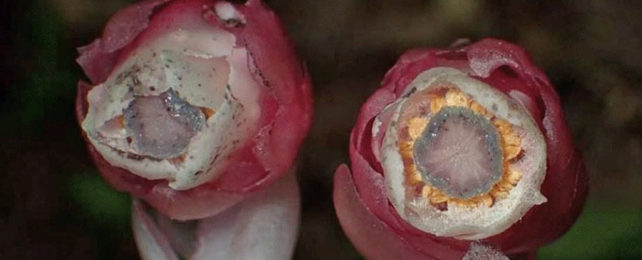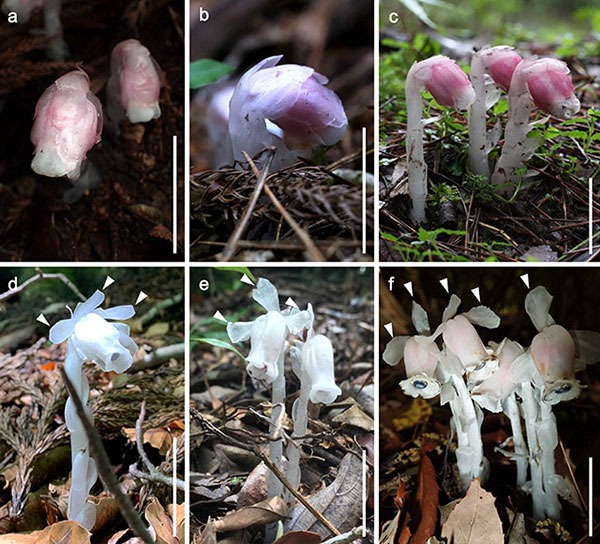Ethereal New Plant Species Doesn't Use Photosynthesis – It's Found Something Sneakier
Nature01 January 2023
By Tessa Koumoundouros

The newly described species' flowers. (Suetsugu et al., J Plant Res, 2022)
Cloaked by the shadows of enchanting Asian woodlands, strange growths can be seen peeking out from between leaf litter like the ghosts of long-dead flowers.
The plant's foliage lacks green pigment having forsaken photosynthesis in favor of an alternative source of nutrients on the forest floor, one stolen from fungi many other plants consider friends – the symbiotic mycorrhizae that connect most forest plants into a wood wide web.
Found widely across East and Southeast Asia, from the Himalayas to Japan, Monotropastrum humile was thought to be a single species. Now researchers from Japan and Taiwan have discovered a pink-hued plant that qualifies as a unique species in its own right, one they've named Monotropastrum kirishimense.
Wood wide webs – incredible networks of fungi and plant roots that span entire forests – act as highways for nutrient deliveries as well as wires for transferring information between plants via electrical and chemical signals. These connections help strengthen a forest as a whole by distributing resources from nutrient-rich to nutrient-poor areas of the network. They also allow plants to warn each other of predators and even help protect them from drought.
In exchange for these services, plants pay their fungi allies with some of the hydrocarbons they produce using photosynthesis.
But Monotropastrum betrays this mutualistic relationship by stealing all its nutrients from the fungi, offering no photosynthetic products to the network in return – making them part of a very selective mycoheterotrophic club.

The new species (top) and M. humile (bottom). (Suetsugu et al., J Plant Res, 2022).
The most distinct feature of the newly-described Japanese variant is its blushing pink petals and sepals, but there are other differences, too, the researchers note.
Unlike their cousin M. humile, the newly discovered plant's roots barely protrude from the soil. They are also more strongly associated with one Russula lineage of mycorrhizae, whereas M. humile favors a completely different variety of fungi.
What's more, despite growing next to each other, M. kirishimense's flowering season doesn't overlap with that of M. humile, blooming 40 days after the better-known species. This study of these life cycle interactions between wildlife and physical forces on earth, such as seasons, is called phenology.
"Our multifaceted evidence leads us to conclude that this taxon is morphologically, phenologically, phylogenetically, and ecologically distinct, and should, therefore, be recognized as a separate species," Kobe University ecologist Kenji Suetsugu and colleagues conclude in their paper.
"Our study presents the exciting possibility that a host shift in M. kirishimense, toward a specific Russula lineage, triggered ecological speciation."
Their different flowering seasons ensure the primary pollinator they share, the bumblebee Bombus diversus, can't accidentally give one species the other's pollen, preventing hybridization.
Many of the world's forests are under threat, and as Monotropastrum species rely on old-growth forests, these strange plants are vulnerable to extinction too. M. kirishimense is rare, and the researchers suspect it's likely endangered.
The new plant was described in the Journal of Plant Research.
THANKS TO: https://www.sciencealert.com/ethereal-new-plant-species-doesnt-use-photosynthesis-its-found-something-sneakier
Nature01 January 2023
By Tessa Koumoundouros

The newly described species' flowers. (Suetsugu et al., J Plant Res, 2022)
Cloaked by the shadows of enchanting Asian woodlands, strange growths can be seen peeking out from between leaf litter like the ghosts of long-dead flowers.
The plant's foliage lacks green pigment having forsaken photosynthesis in favor of an alternative source of nutrients on the forest floor, one stolen from fungi many other plants consider friends – the symbiotic mycorrhizae that connect most forest plants into a wood wide web.
Found widely across East and Southeast Asia, from the Himalayas to Japan, Monotropastrum humile was thought to be a single species. Now researchers from Japan and Taiwan have discovered a pink-hued plant that qualifies as a unique species in its own right, one they've named Monotropastrum kirishimense.
Wood wide webs – incredible networks of fungi and plant roots that span entire forests – act as highways for nutrient deliveries as well as wires for transferring information between plants via electrical and chemical signals. These connections help strengthen a forest as a whole by distributing resources from nutrient-rich to nutrient-poor areas of the network. They also allow plants to warn each other of predators and even help protect them from drought.
In exchange for these services, plants pay their fungi allies with some of the hydrocarbons they produce using photosynthesis.
But Monotropastrum betrays this mutualistic relationship by stealing all its nutrients from the fungi, offering no photosynthetic products to the network in return – making them part of a very selective mycoheterotrophic club.

The new species (top) and M. humile (bottom). (Suetsugu et al., J Plant Res, 2022).
The most distinct feature of the newly-described Japanese variant is its blushing pink petals and sepals, but there are other differences, too, the researchers note.
Unlike their cousin M. humile, the newly discovered plant's roots barely protrude from the soil. They are also more strongly associated with one Russula lineage of mycorrhizae, whereas M. humile favors a completely different variety of fungi.
What's more, despite growing next to each other, M. kirishimense's flowering season doesn't overlap with that of M. humile, blooming 40 days after the better-known species. This study of these life cycle interactions between wildlife and physical forces on earth, such as seasons, is called phenology.
"Our multifaceted evidence leads us to conclude that this taxon is morphologically, phenologically, phylogenetically, and ecologically distinct, and should, therefore, be recognized as a separate species," Kobe University ecologist Kenji Suetsugu and colleagues conclude in their paper.
"Our study presents the exciting possibility that a host shift in M. kirishimense, toward a specific Russula lineage, triggered ecological speciation."
Their different flowering seasons ensure the primary pollinator they share, the bumblebee Bombus diversus, can't accidentally give one species the other's pollen, preventing hybridization.
Many of the world's forests are under threat, and as Monotropastrum species rely on old-growth forests, these strange plants are vulnerable to extinction too. M. kirishimense is rare, and the researchers suspect it's likely endangered.
The new plant was described in the Journal of Plant Research.
THANKS TO: https://www.sciencealert.com/ethereal-new-plant-species-doesnt-use-photosynthesis-its-found-something-sneakier






 Sat Mar 23, 2024 11:33 pm by globalturbo
Sat Mar 23, 2024 11:33 pm by globalturbo

